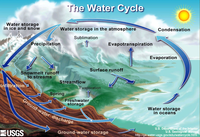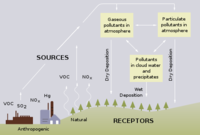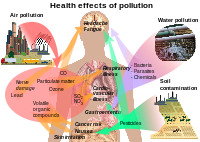Is This Water Sanitary?!
Biology in Middle Schools home | |Elementary School sister project
Biology In Middle Schools is a Saint Michael's College student project. Link under 'toolbox' for a printer-friendly version. Click on handouts to print full resolution versions. Please see Wikieducator's disclaimer, our safety statement, and the Creative Commons licensing in English and in legalese.
Primary biological content area covered
-We will be covering acid rain which is the result of pollutants mixing with moisture in the atmosphere. Many different pollutants can contribute but the problem is mainly caused by factories burning fossil fuels. It is exposed to us in the form of rain. It is harmful to plants and human health.
-The water cycle is when water evaporates into the atmosphere where it condenses and forms clouds. It returns to the earth in the form of precipitation which runs into ponds, lakes, rivers, streams and oceans. Then the cycle continues.
-Pond water contains many bacteria that come from the waste of animals living in and around the pond. Also, runoff carries a lot of bacteria and pollutants that are picked up from the surrounding soil and environment. This eventually enters the pond. Rainwater contains pollutants, soil, plant parts, insect parts, bacteria, algae, and sometimes radioactive materials that the precipitation has washed out of the air.
-Water pollution can have harmful effects on animals as well as humans. We will talk about why it is important to try to prevent water pollution and why pollution can be harmful to our health.
Materials
rain gauge
containers for pond water and tap water samples
pH testing strips
TSA growth plates
glass elbow
Parafilm ®
scissors
labeling tape
sharpie markers
pipettes
Handouts
See thumbnails on right hand side of page (Fig. 1, Fig. 2 and Fig. 3).
Description of activity
Our activity will consist of talking to the students about acid rain as well as the water cycle and give them handouts to better understand these concepts. We will then proceed by using the previously collected rain water samples, pond water samples and tap water sample. This will be followed by testing the pH of each. In addition, the students will make bacterial growth plates of rain water and pond water samples to take back to their classroom and observe results.
Lesson plan
1. Pass out 3 handouts shown in thumbnails on right side of page (Fig. 1, Fig. 2 and Fig. 3).
2. Talk to students about the water cycle (Figure 1) and acid rain (Figure 2) followed by how water pollution affects us as humans (Figure 3) and why this is an important issue.
3. Next, we will explain the project to the students and highlight safety measures that must be taken to avoid contact with potentially harmful bacteria.
4. We will have the students make predictions on the pH of the pond water vs. the rain water vs. the tap water.
5. Students will measure the pH of the pond water, rain water and tap water.
6. We will calculate the average pH for each sample for each group and discuss results.
7. Using tape and sharpies, each group will label three bacterial growth plates as: pond water sample, rain water sample and control (tap water).
8. The students will collect water using a pipette from each of the three containers which hold the three different samples and transfer them to the three respective growth plates.
9. The sample will be spread around on the plate using a glass elbow.
10. The students will carefully Parafilm ® the growth plates so that no leakage will occur and so that no direct contact with the bacteria will occur.
11. Next, we will have the students make predictions on which growth plate will have the most bacteria and which will have the least.
12. We will take a tally of these predictions and give the results to the teacher to bring back to the classroom.
13. We will make sure that the students dispose of all the pH strips as well as put the glass elbows and pipettes back into order. We will set out plates in preparation for the next group.
14. In the classroom, students will observe the plates once the bacteria has grown up.
15. Students can then compare the actual results to their predictions and see how accurate they were.
<input type="hidden" id="gwProxy"></input><input type="hidden" id="jsProxy" onclick="jsCall();"></input>Potential pitfalls
Potential pitfalls of this experiment is that we aren't sure what types of bacteria we will get on the growth plates. Some of these bacteria could be potentially harmful if not handled properly. To avoid any danger from these bacteria, we will talk to the students about safety before beginning the project. We will provide the students with Parafilm ® to cover the growth plates so the students do not come in direct contact with the bacteria. We will make sure to tell the students not to remove the Parafilm ® at any time.
Math connections
The students will report the pH of both the rain water and pond water sample. Then we will calculate the average pH of both sample types among each group and find the difference between the averages of pond water and rain water.
Literature connections
1. Firor, John. 1990. Changing Atmosphere: A Global Challenge.
2. Houston, Charles S., Oris Blackwell. 1972. Water Pollution and Human Health.
3. Howard, Ross, Michael Perley. 1946. Acid Rain: The North American Forecast.
Connections to educational standards
S5-6:48 (DOK 2)
Students demonstrate their understanding of processes and change over time within Earth systems by diagramming, labeling and explaining the process of the water cycle (e.g., evaporation, precipitation, run-off).
Next steps
After completing the activity, additional information that can be found from the material and resources at hand would be what the average difference was in each of the samples relative to our control which was tap water. When the children look at the growth plates later on, they could count the number of colonies and take the average for each type of water sample. After that, they can compare the amount of bacteria on each plate relative to the other. Also the students could look at the types of bacteria found on the plates and see if they look similar or different to the other plates of the same sample as well as other samples. Additional activities that could be developed using the equipment and materials we have at hand would be to test other types of water. For example, we could have tested stream water, puddles of water and/or swamp water in addition to the water samples we already tested. Based on student questions and input, it would be a great opportunity to look at ways they can help the environment by minimizing pollution. We touched upon these topics when talking about acid rain as well as run-off water and their harmful effects.
Reflections
This activity went extremely well with the students! We had approximately 40 5th grade students so we split up each large group (8 students) into 3 small groups (2-3 students)- one group for tap water, one for pond water and one for rain water. Each of these groups ran the pH test and prepared a bacterial growth plate with their respective water samples. This seemed to work well because we found that it wasn't necessary for each student to have their own bacterial growth plates and thus they we able to work together more in teams. Most of the students brought in previous basic knowledge of the water cycle and acid rain and this aided in engaging the students when providing an introduction for the students prior to the experiment.
Although in our case this was not possible because we were not with the students prior to performing the experiment, one thing that I think we could change to make this activity a little more interesting for the students is to have them collect the water sample themselves. Also, we did not experience much confusion from the students for this activity, but one thing that I think we could have done to make clearer for them is to have modeled exactly what we wanted the students to do with extra pH strips and growth plates.
Citations and links
http://www.smcvtonline.org/re/DotNextLaunch.asp?courseid=3796355
http://www-k12.atmos.washington.edu/k12/pilot/water_cycle/teacherpage.html
http://teachers.net/lessons/posts/349.html
http://teachers.net/lessons/posts/1844.html



